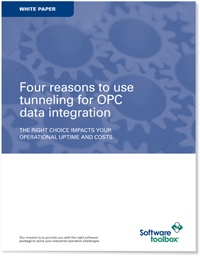Four reasons to use tunneling for OPC data integration
Free White Paper
OPC is the standard of choice for interoperability between software and hardware in the multi-vendor real world. That success has resulted in greater availability of data and has generated greater demand for access to the data across a wider number of locations and users. However, when OPC clients and servers are on different computers, or at remote locations, making a secure, reliable and resilient connection has its challenges and risks.
In this whitepaper, you will learn more about the challenges in multi-computer, networked, and multi-site data integration architectures using OPC, including how OPC clients and servers connect, the role of a technology called DCOM, and how you can overcome them using a technology known as tunneling.
Contents:
- Review of how OPC Servers and Clients connect
- What is an OPC Tunnel?
- 4 Limitations of DCOM and their impact on your operations
- How to estimate the true cost to your business of using DCOM
- How using tunneling overcomes the limitations of DCOM
Complete the form at the right to receive an email with an immediate download of this free white paper.
Get the Whitepaper Now (Check Your Email Inbox)
STAY CONNECTED
1-888-665-3678 (US + Canada)
+1-704-849-2773 (Global)
+1-704-849-6388 (Fax)
support.softwaretoolbox.com
WORKING WITH US
WHO WE ARE
RECENT POSTS
Usage subject to our website terms and conditions.



